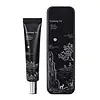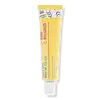What's inside
What's inside
 Key Ingredients
Key Ingredients

 Benefits
Benefits

 Concerns
Concerns

No concerns
 Ingredients Side-by-side
Ingredients Side-by-side

Water
Skin ConditioningGlycerin
HumectantMethylpropanediol
SolventCaprylic/Capric Triglyceride
MaskingCetearyl Alcohol
EmollientMacadamia Ternifolia Seed Oil
EmollientHydrogenated Polydecene
EmollientNiacinamide
SmoothingButyrospermum Parkii Butter
Skin ConditioningGlyceryl Stearate
EmollientBeeswax
Emulsion StabilisingSaccharomyces/Xylinum/Black Tea Ferment
Skin ConditioningArachidyl Alcohol
EmollientBehenyl Alcohol
EmollientArachidyl Glucoside
EmulsifyingPhenyl Trimethicone
Skin ConditioningCetearyl Glucoside
EmulsifyingSorbitan Stearate
EmulsifyingCellulose Gum
Emulsion StabilisingSodium Hyaluronate
HumectantHydrolyzed Hyaluronic Acid
HumectantSodium Acetylated Hyaluronate
HumectantHydroxyethylcellulose
Emulsion StabilisingBroussonetia Kazinoki Root Extract
Skin ConditioningPunica Granatum Fruit Extract
AntioxidantCoptis Japonica Extract
AntimicrobialCentella Asiatica Extract
CleansingAdenosine
Skin ConditioningCeramide NP
Skin ConditioningYeast Beta-Glucan
Skin ConditioningCopper Tripeptide-1
Skin ConditioningAcetyl Hexapeptide-8
HumectantHydrogenated Lecithin
EmulsifyingCarbomer
Emulsion StabilisingButylene Glycol
HumectantHydroxyacetophenone
AntioxidantMyrtus Communis Extract
AstringentTropaeolum Majus Extract
AntimicrobialTromethamine
BufferingDisodium EDTA
Octyldodecanol
EmollientCaprylyl Glycol
EmollientEthylhexylglycerin
Skin Conditioning1,2-Hexanediol
Skin ConditioningWater, Glycerin, Methylpropanediol, Caprylic/Capric Triglyceride, Cetearyl Alcohol, Macadamia Ternifolia Seed Oil, Hydrogenated Polydecene, Niacinamide, Butyrospermum Parkii Butter, Glyceryl Stearate, Beeswax, Saccharomyces/Xylinum/Black Tea Ferment, Arachidyl Alcohol, Behenyl Alcohol, Arachidyl Glucoside, Phenyl Trimethicone, Cetearyl Glucoside, Sorbitan Stearate, Cellulose Gum, Sodium Hyaluronate, Hydrolyzed Hyaluronic Acid, Sodium Acetylated Hyaluronate, Hydroxyethylcellulose, Broussonetia Kazinoki Root Extract, Punica Granatum Fruit Extract, Coptis Japonica Extract, Centella Asiatica Extract, Adenosine, Ceramide NP, Yeast Beta-Glucan, Copper Tripeptide-1, Acetyl Hexapeptide-8, Hydrogenated Lecithin, Carbomer, Butylene Glycol, Hydroxyacetophenone, Myrtus Communis Extract, Tropaeolum Majus Extract, Tromethamine, Disodium EDTA, Octyldodecanol, Caprylyl Glycol, Ethylhexylglycerin, 1,2-Hexanediol
Water
Skin ConditioningPropanediol
SolventButylene Glycol
HumectantGlycerin
Humectant1,2-Hexanediol
Skin ConditioningSodium Polyacryloyldimethyl Taurate
Emulsion StabilisingCetyl Ethylhexanoate
EmollientCorn Starch Modified
AbsorbentIlex Paraguariensis Leaf Extract
PerfumingCetearyl Olivate
Sorbitan Olivate
EmulsifyingPanthenol
Skin ConditioningAllantoin
Skin ConditioningAdenosine
Skin ConditioningTocopherol
AntioxidantHelianthus Annuus Seed Oil
EmollientHydrolyzed Hyaluronic Acid
HumectantSodium Hyaluronate
HumectantHyaluronic Acid
HumectantCaffeine
Skin ConditioningAcetyl Tetrapeptide-5
HumectantCichorium Intybus Root Extract
MaskingWater, Propanediol, Butylene Glycol, Glycerin, 1,2-Hexanediol, Sodium Polyacryloyldimethyl Taurate, Cetyl Ethylhexanoate, Corn Starch Modified, Ilex Paraguariensis Leaf Extract, Cetearyl Olivate, Sorbitan Olivate, Panthenol, Allantoin, Adenosine, Tocopherol, Helianthus Annuus Seed Oil, Hydrolyzed Hyaluronic Acid, Sodium Hyaluronate, Hyaluronic Acid, Caffeine, Acetyl Tetrapeptide-5, Cichorium Intybus Root Extract
 Reviews
Reviews

Ingredients Explained
These ingredients are found in both products.
Ingredients higher up in an ingredient list are typically present in a larger amount.
1,2-Hexanediol is a synthetic liquid and another multi-functional powerhouse.
It is a:
- Humectant, drawing moisture into the skin
- Emollient, helping to soften skin
- Solvent, dispersing and stabilizing formulas
- Preservative booster, enhancing the antimicrobial activity of other preservatives
Adenosine is in every living organism. It is one of four components in nucleic acids that helps store our DNA.
Adenosine has many benefits when used. These benefits include hydrating the skin, smoothing skin, and reducing wrinkles. Once applied, adenosine increases collagen production. It also helps with improving firmness and tissue repair.
Studies have found adenosine may also help with wound healing.
In skincare products, Adenosine is usually derived from yeast.
Learn more about AdenosineButylene Glycol (or BG) is used within cosmetic products for a few different reasons:
Overall, Butylene Glycol is a safe and well-rounded ingredient that works well with other ingredients.
Though this ingredient works well with most skin types, some people with sensitive skin may experience a reaction such as allergic rashes, closed comedones, or itchiness.
Learn more about Butylene GlycolGlycerin is already naturally found in your skin. It helps moisturize and protect your skin.
A study from 2016 found glycerin to be more effective as a humectant than AHAs and hyaluronic acid.
As a humectant, it helps the skin stay hydrated by pulling moisture to your skin. The low molecular weight of glycerin allows it to pull moisture into the deeper layers of your skin.
Hydrated skin improves your skin barrier; Your skin barrier helps protect against irritants and bacteria.
Glycerin has also been found to have antimicrobial and antiviral properties. Due to these properties, glycerin is often used in wound and burn treatments.
In cosmetics, glycerin is usually derived from plants such as soybean or palm. However, it can also be sourced from animals, such as tallow or animal fat.
This ingredient is organic, colorless, odorless, and non-toxic.
Glycerin is the name for this ingredient in American English. British English uses Glycerol/Glycerine.
Learn more about GlycerinHydrolyzed Hyaluronic Acid is a form of hyaluronic acid. It is created by the hydrolysis of hyaluronic acid with a high molecular weight. Once created, Hydrolyzed Hyaluronic Acid has a low molecular weight.
Low molecular weight HA has been shown to hydrate and increase elasticity of the skin. Increasing elasticity is also associated with reduction of wrinkle depth.
One study found topical low molecular weight hyaluronic acid may be considered for the treatment of rosacea in the adult population. However, we always recommend speaking with a professional about your skin concerns.
Hyaluronic acids are a humectant. This means they draw moisture from the air. Hyaluronic acids help moisturize, soothe, and protect the skin.
Read more about other common forms of hyaluronic acid:
Learn more about Hydrolyzed Hyaluronic AcidSodium Hyaluronate is hyaluronic acid's salt form. It is commonly derived from the sodium salt of hyaluronic acid.
Like hyaluronic acid, it is great at holding water and acts as a humectant. This makes it a great skin hydrating ingredient.
Sodium Hyaluronate is naturally occurring in our bodies and is mostly found in eye fluid and joints.
These are some other common types of Hyaluronic Acid:
Learn more about Sodium HyaluronateWater. It's the most common cosmetic ingredient of all. You'll usually see it at the top of ingredient lists, meaning that it makes up the largest part of the product.
So why is it so popular? Water most often acts as a solvent - this means that it helps dissolve other ingredients into the formulation.
You'll also recognize water as that liquid we all need to stay alive. If you see this, drink a glass of water. Stay hydrated!
Learn more about Water